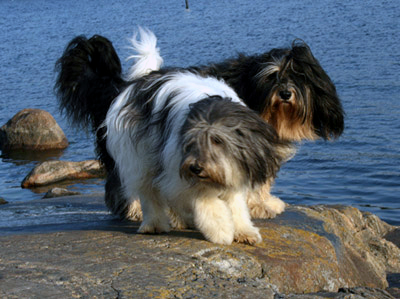

Lani - (Cynia Moscic) and cedr - ( Cedr Moscic) on the run
|
LONG, SHORT OR DOCKED? ON
PONS’ TAILS Breeders
of dogs, that are traditionally docked, have been recently facing a new
challenge – tail docking ban. Currently docking is illegal in
Australia, Denmark, Finland, Germany, Holland, Norway, Sweden,
Switzerland (perhaps also in a few smaller countries) and soon in Great
Britain. In Poland the situation is pretty confusing –
the docking ban does exist, but it’s neither enforced nor
observed....... History It
is well known that naturally short tails
used to be a typical feature of pons;
some of the very first descriptions actually relate to short-tailed
dogs. Dogs, bred in pre-war years in Planta and Milanow, were all bobtails
and this feature is stressed in their description by the late Mrs
Zoltowska, one of the pre-war breeders. When the famous Kordegarda kennel
of pons was established in the 50’, most of the foundation stock were
natural bobtails. In those years, however, tail docking was considered an
obvious procedure; therefore breeders didn’t select deliberately for
this feature, and they did not keep any records of tail lengths at birth.
Yet it’s known for sure that the two great sires of utmost influence on
establishing
the
modern pon
– SMOK
z Kordegardy and DOMAN z Kordegardy -
were both natural bobtails. Genetics Doubtlessly,
this unique feature still exists with the breed and can be successfully
bred for. But, first of all, we have to know what is its genetic
background, how it is inherited, and whether breeding for short tails
increases risk of any possibly linked defects. Originally,
it was thought that short tails was a simple Mendelian trait
(QUALITATIVE), most probably a dominant one. Indeed, there is a vast
evidence that bobtail puppies are born only when one of the parents is a
bobtail. From this point of view, short tail can be inherited
just in the same way as coat colour (e.g. black or brown) or its
type (short or long). Unfortunately, the inheritance of short tails must be far more complex. It is well known that so-called "tural bobtails” come with tails of DIFFERENT length and shape. Given sufficient number of progeny, we will be able to see tails varying from very short, hardly noticeable ones, through different lengths up to full length– in fact, almost an unbroken continuum. When presented in a graph, these results form a typical curve, known as Gauss curve. This is typical of QUANTITATIVE traits of more complex inheritance. They are encoded by large number of genes. Any quantitative trait is measurable, highly variable and rather difficult to fix. Some examples of quantitative traits are height at withers, coat texture and fertility.To
sum up ( I am not going to start a lecture on genetics here!): 1.
A
single Mendelian gene (dominant) decides whether a tail is shortened at
all 2.
A
large group of other genes decide what is the actual length of a shortened
tail and also its shape CONSEQUENCES If the above is true (and there is no strong evidence against!) we must accept that in any litter of natural bobtails there are pups with tails of different length. From my own experience with Pembroke welsh corgis I find that it depends, at least to some extend, on the length of parents’ tails. The shorter they are, the more real "bobtails” in the litter. One of my studs who is a very short "bobtail” produced mostly short bobtails, whereas the other, whose tail is some 6 cms long, produced pups with only partially shortened tails. This is perfectly in agreement with the hypothetical mode of inheritance. One must admit, though, that these partially shortened tails are not very attractive!Additionally,
it will be very difficult to breed only short tails, although long termed
selection may highly increase this probability. Pembroke breeders are far
more advanced in their attempts than pon breeders
and it worthy to note that in Norway, in just a few generations,
they have gained a double increase in numbers of bobtails bred. To
be continued. Miroslaw
Redlicki
|

Kingi - (Flinkbein Srebro) and Lani - (Cynia Moscic) near the sea
ponbreeders/internationalrecipes/faq/pontails/ponparent/apriltherapy/homecooking/ponhoroscopes